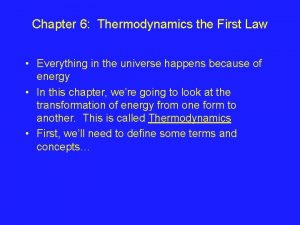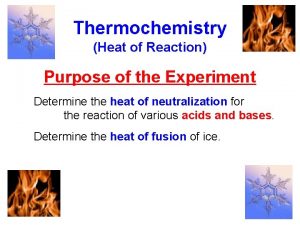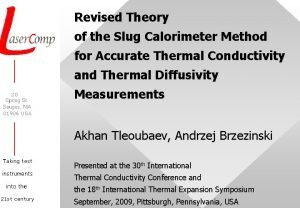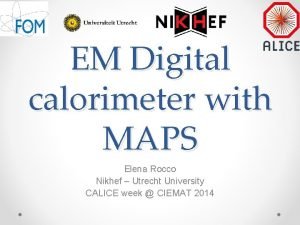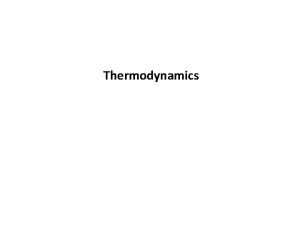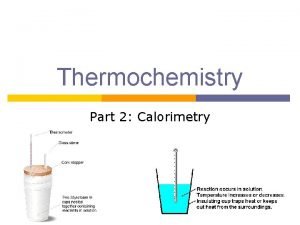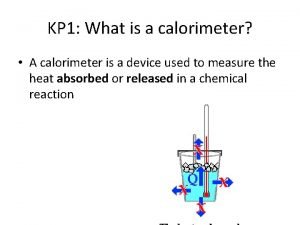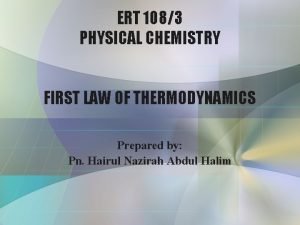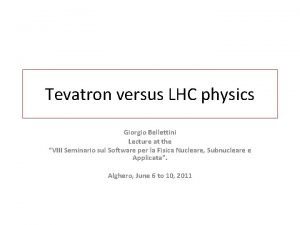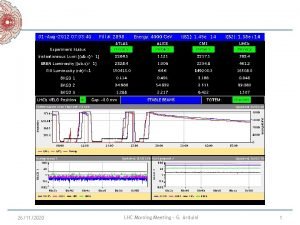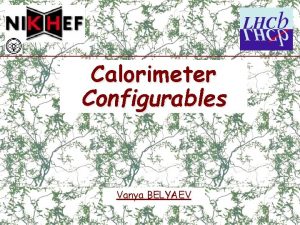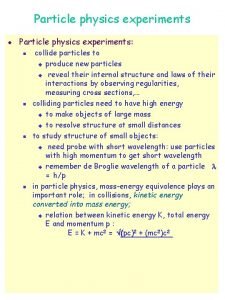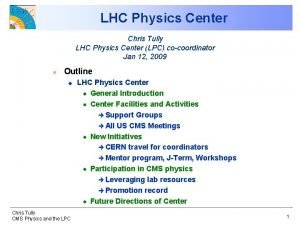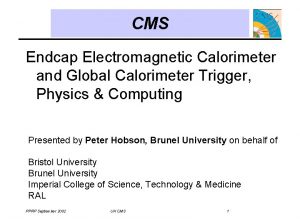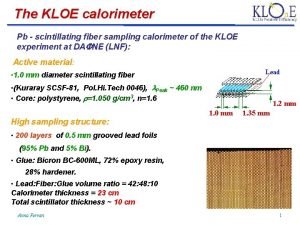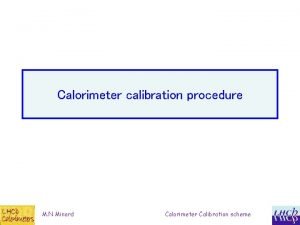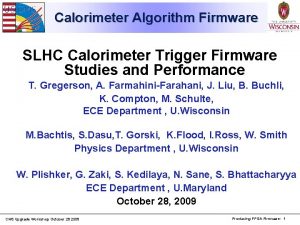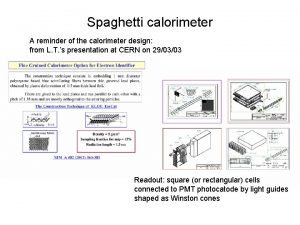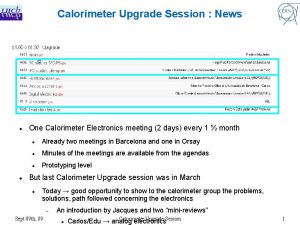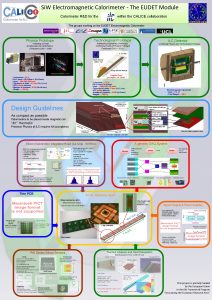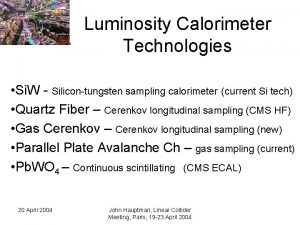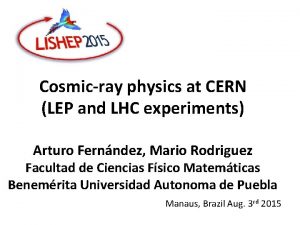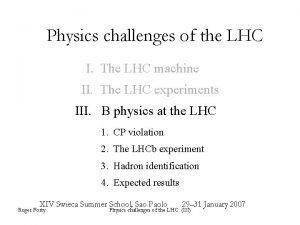Calorimeter Physics general and aspects of LHC experiments

































- Slides: 33

Calorimeter Physics (general and aspects of LHC experiments) Claudio Santoni UBP IN 2 P 3/CNRS Clermont-Ferrand France

Outline • Calorimetric measurements – Electromagnetic calorimeters – Hadronic calorimeters • From Photons to Ge. V (Calibration of Tile. Cal Cells) • From Particles to Jets (Measurement of Jets in ATLAS) 2

Showers Development • • 3

Electromagnetic Cascade Longitudinal Development Lateral Development • • 4

Hadronic Cascade Longitudinal Development Lateral Development • • 5

Energy Response and Resolution • 6

Energy Resolution of EM Homogenous Calorimeters • 7

Energy Resolution of Sampling EM Calorimeters • 8

Energy Response of Hadronic Calorimeters • 9

Energy Response of Hadronic Calorimeters (cont) • Tile. Cal result 10

• Energy Resolution of Hadronic Calorimeters Pion Energy Resolution of a copper quartz fibre Calorimeters Charged particles traversing the fibres generate Cerenkov light predominantly from the electromagnetic component (charged hadrons have a very high Cerenkov threshold). 11

A compensation weighting method (CDHS) • 12

The ATLAS Calorimeters 13

The ATLAS Tile. Calorimeter • p beam (z) 14

The Monitoring Systems The shower energy is obtained as the sum of the energy measured in each PMTs. Non uniformities and instabilities affect the detemination • Monitor gain stability by injecting laser light (532 nm) in each of 9836 PMT’s (precision: <1%) o The PMTs need to operate in a stable way. A change of 1 V in the operating voltage gives a 1% variation in gain 15

The Monitoring Systems • 16

The Monitoring Systems • Charge Injection (stability: 0. 7%) o The charge produced by the PMT’s is digitized by ADC’s. The charge injection system using charges stored in capacitors gives correspondence ADC counts>p. C and electronics linearity. 17

Electromagnetic scale (EM) • The next step is to relate the p. C measured by the PMTs to some “physics” scale to compare experimental and simulated results. This was done by exposing a fraction of the detector modules to electron at TB’s • In ATLAS the HV is set in a way that PMT response to Cs is equal to the one when the EM scale was measured at TB taking into account the Cs lifetime Mean=1. 05 p. C/Ge. V RMS=2. 4% 18

Energy reconstructed for each channel E = AADC CLas CCs C /Sr CCIS EM • AADC : Amplitude in ADC • CLas : Relative variation from Laser system • CCs : Relative variation from Cs system • C /Sr : Factor due to the different sizes of the cells • CCIS : ADC p. C convertion factor • EM : p. C→Ge. V conversion factor from e’s at TB The same energy deposit leads to the same signal at the E. M. scale anywhere in the detector 19

Cell Response Variation • Corrections applied to the PMT response • Down drift due to high instantaneous luminosity • Up drift due to recovery during technical stops • Radiation effects on the scintillating tiles: 2% 20

Performance with single muons • Muon signal in Tile. Cal is well separated from noise • Cosmic muons can be used to cross-check cell energy intercalibration and overall EM scale • Data and MC d. E/dx comparisons as a function of and show good cell intercalibration within one radial layer (2%) • Stability in the last 3 years: ≤ 1. 5% 21

Validation of the EM Scale Using Muons 22

Jets Measurements • 23

Jet Energy Calibration • The jet energy calibration relates the jet energy measured with the ATLAS calorimeter to the energy of the corresponding jet of stable particles entering the ATLAS detector 24

Topological Calorimeter Clusters • 25

EM+JES Calibration Scheme • 26

Average JES corrections 27

Uncertainty on the calorimeter response The uncertainty in the calorimeter response was obtained from the response uncertainty in the individual particles constituting the jet The following single particle response measurements were used In situ single hadron energy measured in a cone around an isolated track with 0. 5 ≤ p ≤ 20 Ge. V/c The pion response measurements measured in the 2004 CTB where a full slice of the ATLAS detector was exposed to pion beams with momenta between 20 Ge. V/c and 350 Ge. V/c 28

CTB: Resolution of high energy pions • The error on the resolution is equal to 1% for all the energies. • The energy resolution in general is narrower in the simulation than in the data. Energy resolution. Data: open points and MC: full points vs. E at = 0. 55 29

CTB: Linearity of high energy pions • The response has been determined with un uncertainty of about 2. 5%. • The MC is able to reproduce the response to within a few percent. Energy response ratio. Data: open points and MC: full points vs. E at = 0. 35 30

The EM+JES systematic uncertainty 31

The EM+JES Jet Energy Resolution The jet energy resolution is determined by exploiting the transverse momentum balance in events containing jets with large transverse momenta 32

Beyond the simplistic EM+JES • 33
 Coffee cup calorimeter vs bomb calorimeter
Coffee cup calorimeter vs bomb calorimeter Coffee cup calorimeter equation
Coffee cup calorimeter equation Constant volume calorimeter
Constant volume calorimeter Hadron
Hadron General aspects
General aspects Homemade calorimeter
Homemade calorimeter Constant volume calorimeter
Constant volume calorimeter Benedict's oxy calorimeter
Benedict's oxy calorimeter Accelerating rate calorimeter
Accelerating rate calorimeter Calorimeter
Calorimeter Dhrxn
Dhrxn Coffee cup calorimeter equation
Coffee cup calorimeter equation Bomb calorimeter uses
Bomb calorimeter uses Bomb calorimeter
Bomb calorimeter Hadron calorimeter
Hadron calorimeter Slug calorimeter
Slug calorimeter Calorimeter
Calorimeter Elena rocco
Elena rocco Burning a match is what type of energy
Burning a match is what type of energy Bomb calorimeter uses
Bomb calorimeter uses 62g
62g Parr calorimeter
Parr calorimeter Calorimetry equation
Calorimetry equation Function of bomb calorimeter
Function of bomb calorimeter Calorimeter
Calorimeter How does a calorimeter work
How does a calorimeter work Calorimeter
Calorimeter Calorimeter constant
Calorimeter constant Tevatron vs lhc
Tevatron vs lhc Lhc louisiana
Lhc louisiana Hl-lhc schedule
Hl-lhc schedule Hep forum
Hep forum Lhc logbook
Lhc logbook Lhc morning meeting
Lhc morning meeting


